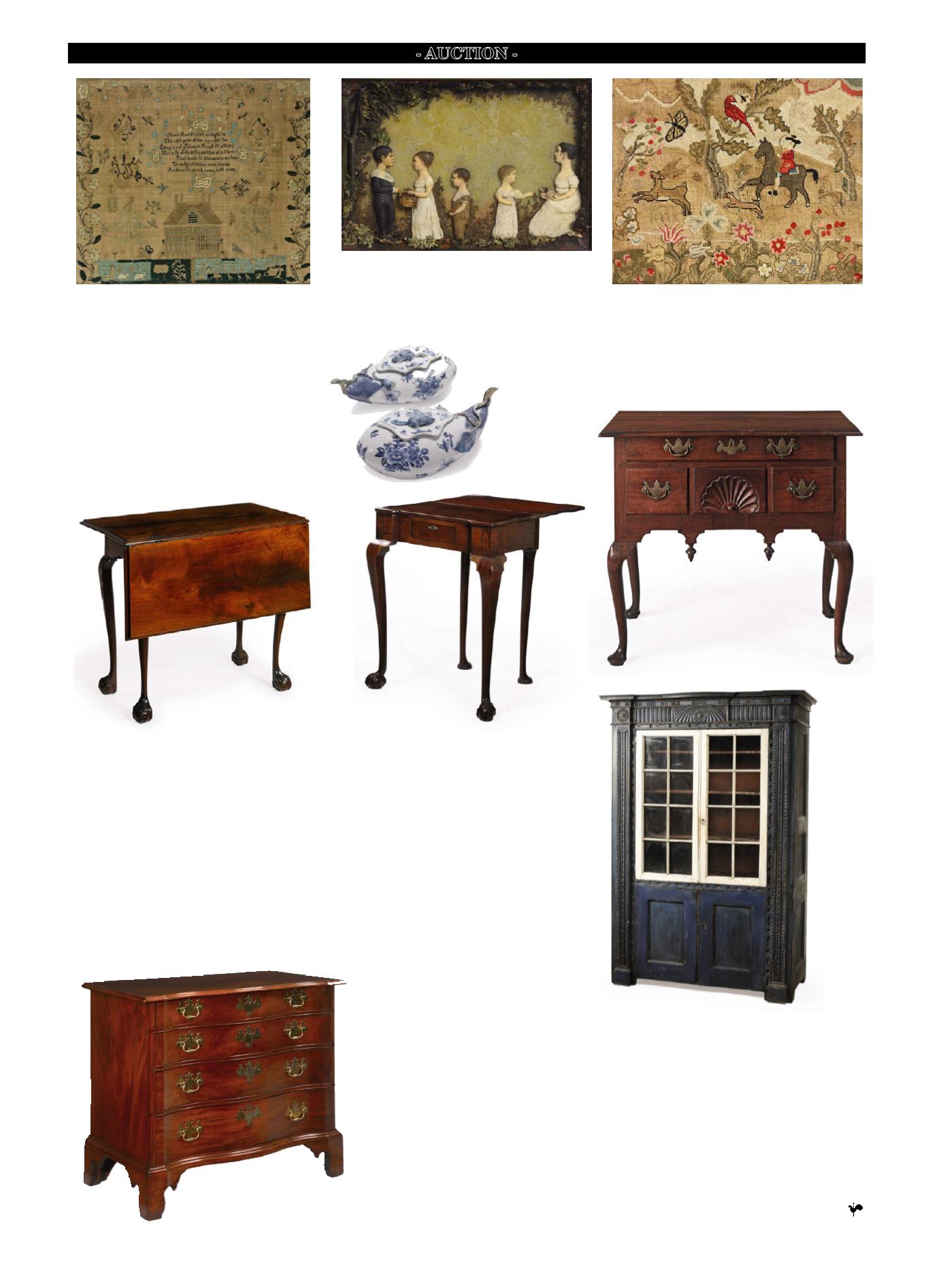

Maine Antique Digest, April 2015 21-B
- AUCTION -
Figured mahogany serpentine-front chest of drawers,
Boston, Massachusetts, circa 1770, 30½" x 36" x 20",
branded “E. Huse,” ex-Israel Sack, Inc., $20,000 (est.
$15,000/30,000) to a bidder on the phone. The serpen-
tine-shaped top with squared protruding ends is above a
case of four graduated serpentine drawers with blocked
ends and retaining original willow brass handles and
escutcheons; the molded base is supported by four straight
bracket feet with spurred and logical inner contours; the
left rear foot facing was replaced in the late 19th century.
The Huse name branded to the backboard of the chest
is likely a fire brand rather than that of a cabinetmaker, as
previously documented.According to the catalog, “The prac-
tice of branding one’s furniture in case of fire or theft was
followed in a number of New England towns, especially
Portsmouth, New Hampshire. The Huse surname can be
found in and around Essex County, Massachusetts, in the
18th century. One possible candidate is Enoch Huse, who
was born October 12, 1732, in Newbury, Massachusetts.
He married a Rebecca Dennison in Ipswich on November
9, 1754, and died in Harvard on April 27, 1821. Another pos-
sibility could be Ebenezer Huse, born December 25, 1750, and died
September 15, 1832.”
The set of three wax relief portraits by Johann Christian
Rauschner (b. 1760) depicting the Nahum Piper family of
Boston, of colored wax heightened with metal wire and
pearls on a painted glass ground in églomisé glass mats
and shadow box frames, Mr. and Mrs. Piper 7" x 6¼"
each, the Piper children 9" x 13", sold in house for $31,250
(est. $5000/7000).
Partially completed wool and silk canvaswork picture
with a hunting scene, Boston, Massachusetts, circa 1750,
25" x 29½", ex-Amy Finkel of M. Finkel and Daughter,
$8750 (est. $10,000/15,000).
Needlework sampler by Sarah Reed, Burlington County,
New Jersey, dated 1830, worked in silk stitches on a linen
ground, 22" x 26", signed “Sarah Reed's work wrought / in
the 13th year of her age. 1830 The / Daughter of Solomon
Reed + Mary / His Wife…,” $13,175 (est. $15,000/25,000).
According to the catalog, “Sarah Reed’s sampler is part
of one of the most important group of Quaker samplers
worked in Burlington County, New Jersey. A virtually
identical example worked by Sarah’s sister, Ann, also in
1830, was recorded but unpublished by Betty Ring. Other
examples are the ‘compendium sampler’ dated 1827, and
sold in the Americana Collection of the late J. Amory Has-
kell, Parke-Bernet Galleries, New York, 1944, and the sale
of the collection of Joan Stephens, Sotheby’s, January 19,
1997…,” which sold for $145,500 to C.L. Prickett. Other
related examples are included in
Hail Specimen of Female
Art!: New Jersey Schoolgirl Needlework, 1726-1860
, the
exhibition at the Morven Museum in Princeton, New Jer-
sey, that runs through March 29.
Pair of Chinese
export porcelain
blue and white
e g g p l a n t - f o r m
sauce tureens and
covers, circa 1775,
9" long, $7500 (est.
$3000/5000).
The Mottley family carved walnut
dressing table, Salem, Massachusetts,
circa 1760, with its original cast brass
hardware and an old surface, 29¼"
x 33¼" x 20¼", ex-Israel Sack, Inc.,
sold for $37,500 (est. $15,000/25,000)
to Exeter, New Hampshire, dealer
Peter Sawyer in the room.
The big discovery at this sale was made at the presale exhibition
when scholar Kemble Widmer suggested that the Whipple family
diminutive mahogany single-leaf bedroom table, circa 1770, cat-
aloged as made in Ipswich or Salem, Massachusetts, was instead
made in Portsmouth, New Hampshire, and that the carving is by
John Davis.
“It has unique construction,” said Sotheby’s Erik Gronning.
“The glue blocks are secured with pins, and this is not a character-
istic of Salem but is found on Portsmouth tables. Kemble Widmer
pointed it out to me, and there it is spelled out in Brock Jobe’s book
on Portsmouth furniture. Then when I compared the carving to
John Davis’s carving also illustrated in the
Portsmouth Furniture
book, it became clear that this is the work of Davis in Portsmouth.”
The Nutts bought this rare table from Israel Sack, Inc. when it
was offered as a Salem piece. The 25½" x 30¼" x 16" table sold
for $21,250 (est. $15,000/30,000) to private collectors in the room.
According to the catalog, it is the only table of this single drop-leaf
design with carved knees. Elizabeth A. Davison recently wrote an
article about the Scottish origin of bedroom tables in the American
South, published in the on-line MESDA
Journal of Early Southern
Decorative Arts
, Volume 35 (2014).
Diminutive mahogany games table, Boston,
Massachusetts, circa 1770, 27½" x 22½"
x 12¾", the rectangular top and case with
concave block center and sides, the front
containing a small drawer, the cabriole
front legs ending in ball-and-claw feet with
swept-back talons, the turned rear legs
tapering into platform-pad feet and slid-
ing back to support the leaf, ex-Israel Sack,
Inc., $43,750 (est. $20,000/30,000).
Livingston family Federal blue-painted carved pine
freestanding cupboard, 78½" x 51½" x 22", Hudson River
valley, circa 1790, of stile and paneled construction, fitted
with two glazed doors above and two flat paneled doors
below; the upper section having three shaped shelves;
the lower section having one shelf; the whole having a
shaped cornice, carved frieze, and carved, fluted, and
blocked columns; the carved elements including shells,
fans, pinwheels, and swags; $28,125 (est. $25,000/35,000)
to a designer in the room who bought a number of lots of
small boxes.










